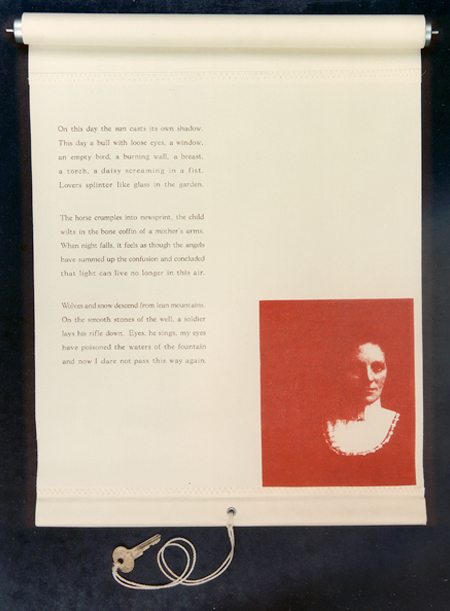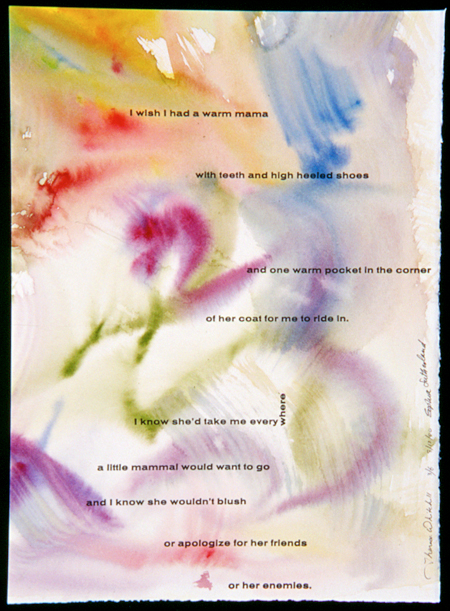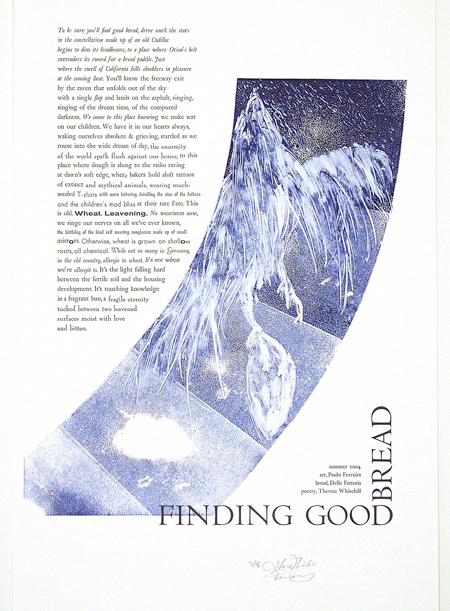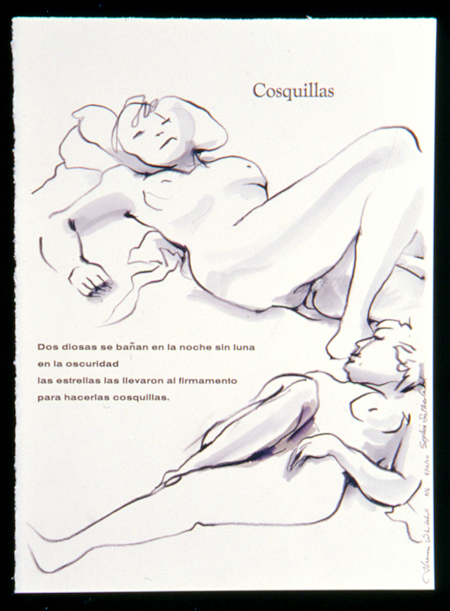Following are the independent bookstores who are carrying my recently published collection of poetry, A…
BROADSIDES
BROADSIDES
A broadside is a limited edition print with literary content. It is a poster with a poem in it, and usually, an image. This definition changes, however, depending upon which century you happen to be in. At one time it would have been hard to know anything about anything without broadsides. Between the fifteenth and the eighteenth centuries, they were the everything of communication—the radio drama, television news, billboard, CD ROM, public opinion poll, and tabloid all rolled into one.
Broadsides were simply sheets of paper printed on one or both sides. They were passed from hand to hand, posted on walls, or available at your bookseller down the street for a pittance. You learned the local news from them, as well as the neighbor’s opinion on that news, the little song ditty composed over yonder, the recent papal bull, or the polemic of the revolution in the American colonies.
In 1913, when poet Blaise Cendrars and artist Sonia Delauney collaborated on their project, “La Prose du Transsibérien et de la Petite Jehanne de France,” they referred to it as “the first simultaneous book.” This simultaneous book was printed on a sheet that unfolded to a length of two meters. An edition was planned of 150, which, when laid end to end, would equal the height of the Eiffel Tower. Only 60 copies were completed, due to interruption by World War I, a poor reception from the public, and the enormous amount of work Delaunay had to do to hand paint each broadside.
The thoughtfulness, collaboration, and humor which they brought to this project is typical of broadside work, as is the passion to present poetry in a form so related to the illustration that it becomes a new genre.
“We are introducing and inventing ourselves,” Mendocino artist Sam Katz explained when discussing his own work on broadsides. His definition reminds me why I practice this art form myself.
In April of 1994 I took my nine-year-old daughter to the Huntington Library in Pasadena to visit their copy of the Gutenberg bible. It is a complete, bound copy, a rarity in the twentieth century. Many of the original bibles printed by Gutenberg have been unbound and sold off page by page to collectors. Although it was not the first use of moveable type (the Chinese were making clay type in the eleventh century), it is the first entire book printed from individual pieces of type on a printing press. When we arrived at the museum, we found that the incunabula books (books printed during the fifteenth century, considered the incunabula, or cradle, of printing) had been moved to another room to make way for an exhibit on Abraham Lincoln. The smaller exhibit space included a wall of broadsides with the following descriptive label:
“BROADSIDES: Official announcements, news bulletins, the latest songs, lurid crime reports, and other information of short-lived or general (and often sensational) interest were available to the reading public in broadsides, single sheets of paper printed on one side only and sold, unbound, by local booksellers.
“These were the newspapers and magazines of their day, cheap, quickly produced, meant to be read and enjoyed for the moment, and easily tossed away. As a result few survive today; the Huntington’s collection is particularly strong.”
Broadside is also a naval term which means the firing of all of a ship’s cannons from one entire side directly at another ship, a most devastating blow. This definition comes to mind when describing the political tracts printed during the American Revolution and posted on town walls.
Only in the twentieth century, with the increase in communication technology and the fading of the use of hand set lead type, has the broadside become what it is today, a source of first edition printing of poetry and art. They can also be examples of fine printing, often on handmade papers.
Rita Warnock, curator emeritus of the Broadsides Collection of the John Hay Library at Brown University, wrote that “Webster defines a broadside as ‘a sheet of paper printed on one or both sides.’ and indeed that is the basic criterion for anything in the Broadsides Collection. That sheet of printed paper can appear in many formats…Whatever form it takes, once flattened out it has to reassemble into one uncut sheet of paper.”
The collection at Brown University focuses on broadsides printed in the United States. The collection in 1928 numbered 8,000 items. Today there are over 44,000, the oldest piece dating from the year 1612. Major groups within the collection include poetry broadsides, printers’ ephemera, those relating to the history of Rhode Island, war posters from the two World Wars, postcards, fine art prints, and bookplates. The collection is available for research in a range of disciplines, as broadsides cut across a wide variety of social and artistic subjects.
Broadsides also speak for themselves, as you will notice in the accompanying illustrations. Even in their more limited modern role they are an entire form of communication. What I like about the form is that the poem is not so much read, as viewed by the observer, and the impact this has on the viewer is different than simply reading a text. You live with a broadside the way you live with a painting. Through the layers of time I see a form intended for immediacy of impact, the unavoidable provoking of thought and discussion, and a sensual impression of words combined with the act of reading.
Jane Grabhorn was a San Francisco printer and bookmaker working during the mid-twentieth century. She married into a printing family in the thirties, and proceeded to practice her own brand of typography, which was irreverent, humorous and cranky, by all accounts. For a while she promoted the idea that hyphens at the ends of lines were ludicrous. A word that needed to be split should simply break and begin again on the next line. It seems that the day Judy Garland died, something stuck in Jane’s craw. As it was aptly put by Glenn Todd, Editor of the Arion Press, (originally the Grabhorn/Hoyem Press):
“Judy had a cult following in San Francisco that was unequaled anywhere else, but the rows of young men swooning in unison or storming the aisles to fling roses to the quavery strains of “Over the Rainbow” put Jane’s teeth on edge and sparked her malice. And there were Judy’s headline-grabbing suicide attempts—how many? four, five, six?—after too much booze and pills. Jane had her own set of problems, some of which dovetailed with Judy’s, and she grew tired of the singer’s antics. When Judy finally dozed off into the Big Sleep in 1969, Jane rushed for her composing stick and whipped out a broadside:
“‘This establishment is closed for the death of Judy Garland.
THOSE WHO DO NOT CARE, WALK IN.’
“She posted a copy on the door of the print shop at 566 Commercial Street; others were placed on the doors of neighboring financial institutions.”
And that is a broadside – interactive literature.
COLORED HORSE STUDIOS
My first broadsides came out of the Book Arts program at Mills College, where I learned letterpress printing and typesetting as an undergraduate under Kathy Walkup from 1981 to 1983. I produced a window shade broadside, a scroll poem, a newspaper insert, a poem to fit in pockets, and developed ideas for a towel dispenser poem (I still need to find one of those circular towel dispensers so common in truck stop bathrooms), and poems that can be printed on tablecloths and curtains.
Moving to Mendocino County in 1985, after a trip to Greece, I began working for Zida Borcich at her letterpress shop in Fort Bragg, as well as heading the letterpress printing program at the Mendocino Art Center, “Gray’s Trousers Press.” The Art Center press lost its funding after a year, but I ended up working for Zida for eight years (minus another year spent back in Greece). I began my first day working for her by pieing (dropping) a brand new font of metal type all over the floor, and went on to become co-production manager.
Zida encouraged me to begin printing broadsides again after a holiday of six years. She set the example by producing her own broadside, “Pundits,” a poem inspired by her father. We formed “Dancing Fools Press” for our collaborations, based on a hand tooled brass embossing die of some old boots I found while scavenging used type at a dealer in San Francisco (Jim Heagy, now retired). The boots are so detailed you can see the holes in the toes—real tramps’ boots. “Whore’s Shoes Press,” I said. “Dancing Fools Press,” she said, because of our habits at the Caspar Inn, a local boogie palace.
I formed Colored Horse Studios in the fall of 1993 with my husband, Paulo Ferreira, an artist and sculptor who quickly became a designer and producer of broadsides. A big boost to my work came from taking a class in fabric printing from Lolli Jacobson at the College of the Redwoods in Fort Bragg, applying what I learned to printing on paper. I spent my semester researching and testing water-based, non-toxic silkscreen inks. Nothing was simple. Nothing ever is with broadsides and me. I don’t think it’s supposed to be. We’re inventing and introducing ourselves, a very delicate and honorable profession.
THERESA WHITEHILL
www.coloredhorse.com
To view the broadside portfolio of Colored Horse Studios: http://www.coloredhorse.com/WritingPoetry/BroadsidesBooks.html
Author’s note: This article has undergone a light update to some of the content since it was first published in the Mendocino Art Center’s publication, Arts & Entertainment, in September of 1993. It was originally intended for a lay audience.
The current article, in which the illustrations noted below were reproduced, was reprinted as Broadsides: Interactive Literature, in Ampersand: The Quarterly Journal of the Pacific Center for the Book Arts (San Francisco, California: Pacific Center for the Book Arts, Susan Angebranndt, editor) Spring 2008, Volume 25, No. 3.
* * * * *
The oeuvre of Colored Horse Studios broadsides now amounts to eighteen pieces, spanning 1983 to 2007. These broadsides, along with the poetry of Theresa Whitehill are in the collections of the following institutions: The John Hay Library at Brown University, San Francisco Public Library, the Special Collections Research Library at UCLA, the Bancroft Library at UC Berkeley, the Butler Library of Columbia University, New York Public Library, Mills College Special Collections, the Getty Center, Stanford University Special Collections, City College of San Francisco, and Los Angeles Public Library. Her work in digital broadsides has been featured by the American Film Institute.
CAPTIONS AND CREDITS FOR ILLUSTRATIONS
1. “Causæ Veteris epitaphium in atecessum, ab anonymo autore scriptum,” a Latin epitaph for the Puritan “Old Cause,” fragment of a larger broadside printed in 1682 in England. An example of political poetry, it is the oldest broadside in the Broadsides Collection of John Hay Library at Brown University; the whole now exists as 4 pieces, each 29 x 18 cm (reprinted by permission of Brown University, John Hay Library, Broadsides Collection)
2. “An elegy in Memory of the Worshipful Major Thomas Leonard Esq. of Taunton in New-England; Who departed this Life on the 24th. Day of November, Anno Domini 1713. In the 73d Year of his Age,” a Memento Mori printed in Boston in 1713, 32 x 22 cm (reprinted by permission of Brown University, John Hay Library, Broadsides Collection)
3. “A Typographic Discourse for the Distaff Side of Printing, a book by ladies,” composed and printed by Jane Grabhorn, Jumbo Press, 1937, San Francisco, showing not only her eccentric punctuation, but her defense of the practice; 15“ x 9“, printed on 2 sides & folded to 7 1/2“ x 4 1/2“ (courtesy of the Robert Grabhorn Collection on the History of Printing & the Development of the Book, San Francisco Public Library)
Broadsides copyright © 1984–2006 Colored Horse Studios, All Rights Reserved
Unless otherwise noted, the following broadsides have been designed and printed by Theresa Whitehill, Colored Horse Studios
4. “Guernica,” windowshade broadside, silkscreen & letterpress (lead type on window shade fabric, printed on a Vandercook Cylinder Press at Eucalyptus Press, Mills College); Poetry Copyright © 1990 Joe Smith, All Rights Reserved; 14“ x 18“, 1983
5. “Cosquillas,” part of “Diosas,” a suite of four broadsides, hand-rendered artwork & letterpress (lead type printed on a Vandercook No. 4 Proof Press at Colored Horse Studios, Elk, California); Poetry Copyright © 2000 Sophia Sutherland and Adeet Truesdale, All Rights Reserved; Artwork Copyright © 2000 Sophia Sutherland, All Rights Reserved; 11“ x 15“; 2000
6. “Warm Mama,” part of “Diosas,” a suite of four broadsides, hand-rendered artwork & letterpress (lead type printed on a Vandercook No. 4 Proof Press at Colored Horse Studios, Elk, California); Poetry Copyright © 2000 Theresa Whitehill, All Rights Reserved; Artwork Copyright © 2000 Sophia Sutherland, All Rights Reserved; 11“ x 15“; 2000
7. “Blurring,” a type specimen and winter solstice broadside, letterpress (lead type printed on a Vandercook No. 4 Proof Press at Colored Horse Studios, Elk, California); Poetry Copyright © 2000 Theresa Whitehill, All Rights Reserved; Artwork comes from an old engraving; 8“ x 22“; 2000
8. “Finding Good Bread,” broadside, monoprint and letterpress (lead type, printed by Theresa Whitehill and Paulo Ferreira on a Vandercook No. 4 Proof Press at Colored Horse Studios, Ukiah, California); Poetry Copyright © 2004 Theresa Whitehill, All Rights Reserved; Artwork Copyright © 2004 Paulo Ferreira, All Rights Reserved; Bread by Della Fattoria, Petaluma, California; a commission by Sonoma Slow Food; 15“ x 22“; 2004
SOURCES:
Cendrars/Delauney Broadside:
Monica Strauss, “The First Simultaneous Book,” Fine Print, Volume 13, No. 3, July 1987, pages 139-140, followed by a fold-out reproduction in color of the full broadside, from the collection of the New York Public Library, as well as a translation of the poem from French into English.
Huntington Library Broadside Notice:
Alan Jutzi, Curator of the Huntington Library Rare Book Department, in a letter to the author dated June 8, 1994, provided the wording of a broadside notice from their exhibit hall.
The Chinese and moveable type:
Michael Olmert, The Smithsonian Book of Books, Smithsonian Books, Washington, D.C., © 1992 Smithsonian Institution, pages 64–65 deal with the chinese making type of baked clay between the years 1041 and 1049, and the first Korean type foundry in 1392.
Broadsides & Brown University:
Rita H. Warnock, “Broadsides, Yesterday and Today: The Broadside Collection at the John Hay Library,” Rhode Island Library Association Bulletin, Volume 65, Number 6, June 1992, pages 1–3.
Rita H. Warnock, Curator Emeritus of the Broadsides Collection of the John Hay Library at Brown University, in a letter to the author dated June 8, 1994, provided additional information about the collection.
Broadsides & Jane Grabhorn:
San Francisco Public Library: Information about broadsides in general and Jane Grabhorn in particular was provided by research at the San Francisco Public Library’s Special Collections, under the kind direction and assistance of Andrea Grimes, Curator.
Glenn Todd, Editor of the Arion Press, in a letter to the author dated July 5, 1994, provided the colorful account of Jane Grabhorn’s notice of Judy Garland’s death.



